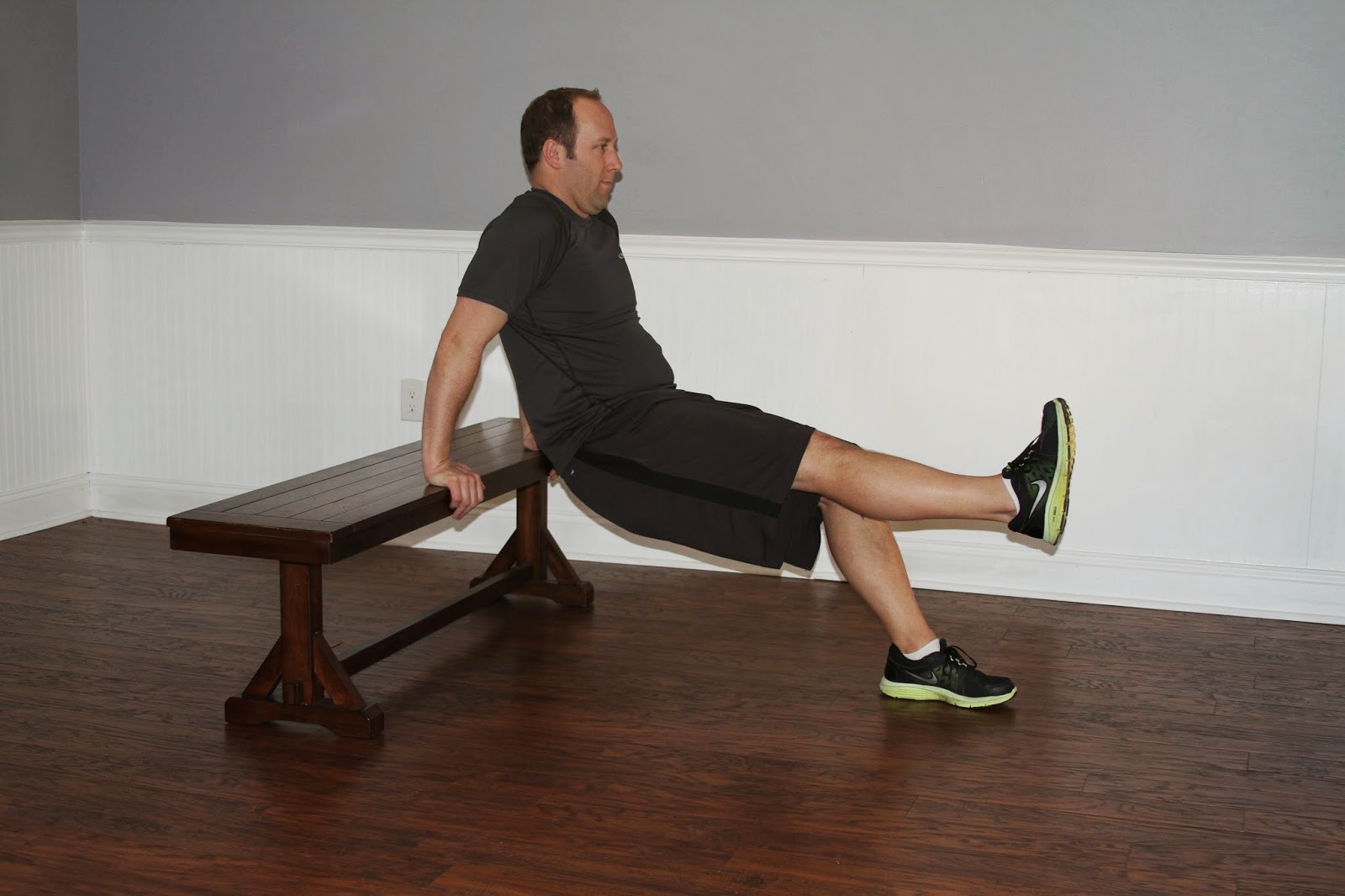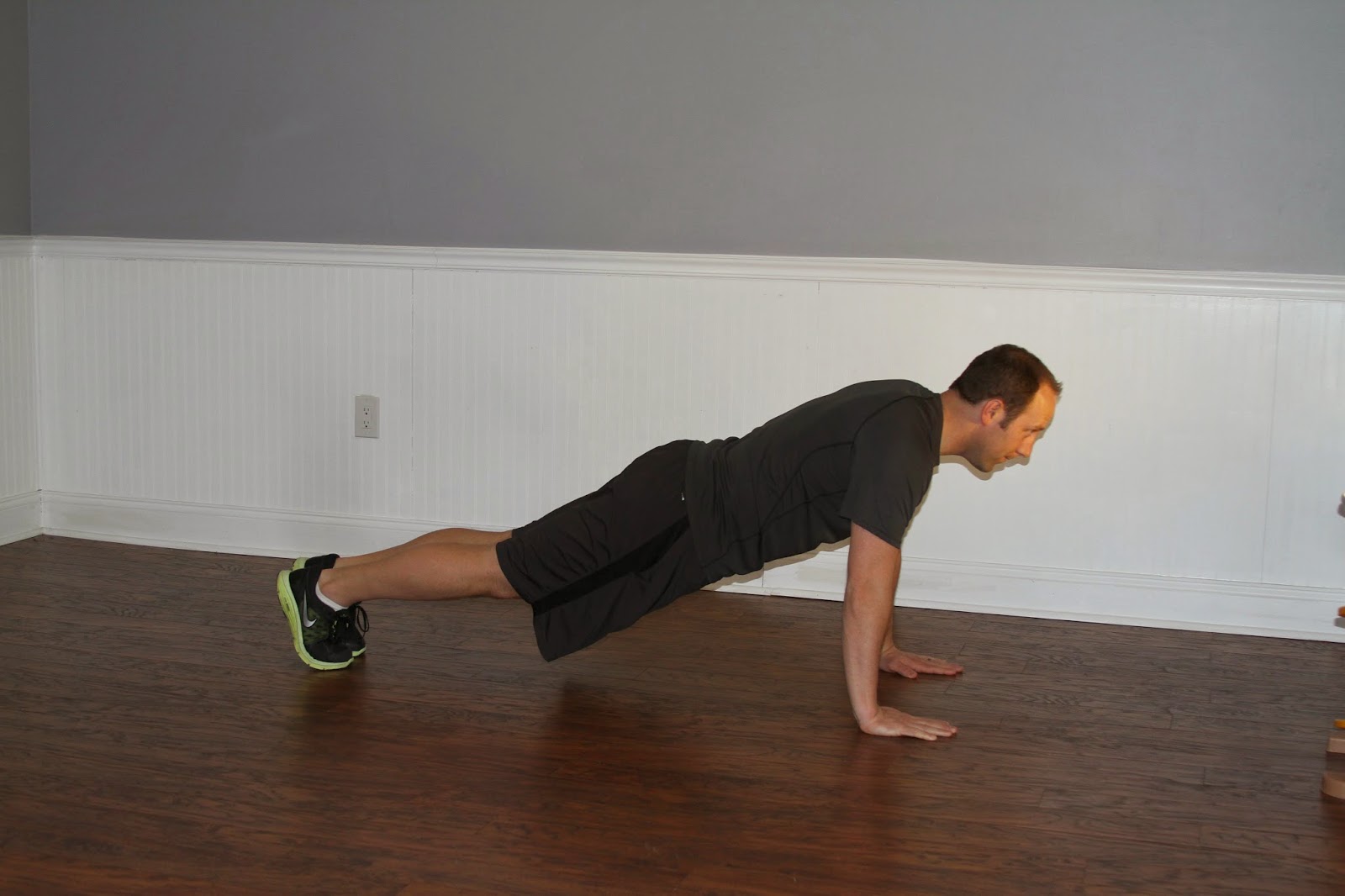Compound exercises or Multi-joint exercises are exercises that utilize more than one muscle group at a time. As opposed to isolated exercises that focus on one primary muscle, such as a bicep curl or leg extension. Compound exercises can lead to a more time-efficient workout while still gaining strength. In short, they give you more 'bang for your buck'. These exercises also help raise your heart rate so there is a bit of an aerobic quality to them as well.
You may recognize my model for the different exercise demo's...my husband, is a trooper. He asked if this was my way of getting him to workout! No! But he did break a little sweat. :)
I was limited to space in my basement for the pictures this time around so please read the instructions for added variability to some of the exercises. Also, it is more important to focus on your form while performing these exercises than it is how many you do.
SAMPLING of COMPOUND EXERCISES/MULTI-JOINT EXERCISES
Squat
Targets: Glutes, Hamstrings and Quads
Begin with feet about shoulder width apart, shoulders back and core tucked in. Bend knees while taking hips back and keeping back firm. Hands can come forward to counter shift in weight. Lower body as low as you can go without having your knees going past your toes.
Alternate: Hands can also be holding dumbbells or other resistance equipment to add more of a challenge and when coming back to a stand, add a bicep curl and/or overhead shoulder press.
Squat with Lateral Raise:
Targets: Quads, Glutes, Hamstrings, and Shoulders
Holding a weighted bar or dumbbells (we are just using a stick for image purposes) assume the squat position and while lowering into the squat, raise arms so they close to parallel with the floor.
Mountain Climbers
Targets: Shoulders, Core, Butt and Quads.
Begin by placing hands and feet on floor extend one leg back while bringing the other foot up towards your hands, allowing your knee to come up as close to your shoulder as you can. In a quick movement, switch feet and repeat.
Alternate: To add a bit more resistance you can put paper plates or sliders under your feet and glide your feet, rather than do the jumping motion.
Push-up with Single-Leg Raise
Targets: Chest, Shoulders, Upper and lower back, Hamstrings
Assume plank position, keeping hands just outside shoulder width and under shoulders. Lower body towards the ground, aiming for a 90 degree angle with your elbows while slightly raising one leg, just enough to engage the hamstring and glutes, then raise your body back up and lower leg. Repeat with alternating legs.
Lunge with Torso Rotation
Targets: Glutes, Hamstrings, Core, Shoulders
Begin with a forward lunge, keeping knee over ankle. While holding a stability ball, medicine ball or dumbbell, hold arms straight out and rotate at the waist from one side to the other. Stand up and switch lead legs and rotate again.
Side Lunge
Targets: Quads, Glutes, Adductors
Assume starting position for squat (feet shoulder width apart, shoulders back, tall posture). Step out far to the side so that the non-bending/nonweight-bearing leg is mostly straight. The weight bearing leg should bend at the knee but the knee should not extend past the toes. Keep hips low and back and lower as much as possible without pain. Alternate sides.
Dead-lift with Bent-over Row
Targets: Hamstrings, lower back and upper back
Holding a weighted bar or dumbbells, hinge at the hips and lower upper body towards feet. Keep bar close to your body and keep a slight bend at the knee. Go down as far as possible before bending knees too much. Keep back flat and eyes up. In the bent over position raise elbows, lifting the weight, then return the weight but maintain the bent over position and repeat the rowing motion for as many reps as you are able.
Plank with Leg-Raise
Targets: Shoulders, Core, Chest
Begin by placing hands directly under shoulders and about shoulder width apart. Keep body in a linear form from toes to head, maintaining flat back, avoid sagging or arching of the back. Hold Belly button in towards the spine. Hold position, starting at 15 seconds, eventually gaining strength to hold for a minute or more.
Plank - Jack
Targets: Shoulders, Upper and Lower Back, Core (lower abs)
Assume plank position with straight arms, be sure to maintain a flat back and avoid sagging or arching back. Jump legs out and return them (just like a jumping jack). This is a quick movement but be sure to maintain good form and posture while moving legs in and out.
Tricep Dip with Single-leg Raise
Targets: Triceps, Core, Quads
Using a bench or chair or edge of sofa, sit right on the edge with hands at your side. Inch your body off the edge and lower your body while one leg is straight out and raised. Repeat the dip but alternate which leg is raised.
Inchworm with Push-Up
Targets: Hamstrings, Upper and Lower Back, Chest and Shoulders
Begin in a standing position. Keeping legs as straight as possible, bend over and place hands on ground. Start walking hands out while keeping your feet planted. Walk hands out as far as you would to get in a push-up position. Perform a push-up and walk hands back towards your feet.
There are so many more compound exercises- I tried to focus mainly on ones that do not use any equipment so that they can done anywhere!
When just using body weight- it can be a better challenge to perform them for a certain amount of time, like 30 seconds, rather than putting a number to them but either way you want to be sure your form is great before adding weight or going through them too quickly. Also, you want your targeted muscles to feel fatigued after each set of exercise and that number will vary with each person.
If you try any and need further instruction or modifications to make them less/more intense please ask me by email or leaving a comment.















































